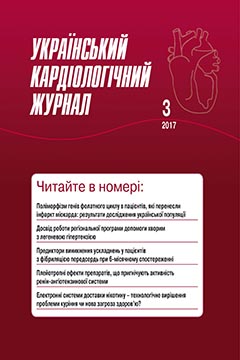Pleiotropic effects of drugs suppressing renin-angiotensin system activity, their importance for clinical practice
Main Article Content
Abstract
Renin-angiotensin system (RAS) antagonists (angiotensin-converting enzyme inhibitors and angiotensin II receptor blockers) are now widely used in the clinical practice. Though arterial hypertension remains the most important indication for these drugs, many major clinical studies showed their organ protecting properties which are not completely dependent on antihypertensive action. They manifest with effective preventing of progressing and even partial regression of target organ damage with pronounced cardio-, angio- and renoprotective action. This served a basis for usage of RAS antagonists in patients after myocardial infarction, at the presence of cardiosclerosis and heart failure. Multidirected action of these drugs is manifested also by their ability to improve metabolic disturbances, especially changes of lipid and glucose metabolism, by prevention of the development and progression of type 2 diabetes mellitus and atherosclerosis. Analysis of the contemporary literature is devoted not only to the description of the RAS antagonists effects but also to the mechanisms of their pleiotropic action which are basis for their therapeutic effects.
Article Details
Keywords:
References
Ceconi C., Fox K.M., Remme W.J. et al. ACE inhibition with perindopril and endothelial dysfunction. Results of a sustudy of the EUROPA study PERTINENT // Cardiovasc. Res.– 2007.– Vol. 73.– P. 237–246.
Dagenais G.R., Pogue G., Fox K. et al. Angiotensin-converting enzyme inhibitors in stabe vascular disease without left ventriculasr systolic dysfunction or heart failure: a combined analysis of these trails // Lancet.– 2006.– Vol. 368.– P. 581–588.
Dahlof B., Devereux R.B., Kjeldsen S.E. et al. Cardiovascular morbidity and mortality in the Losartan Intervention For Endpoint reduction in hypertension study (LIFE): a randomised trial against atenolol // Lancet.– 2002.– Vol. 359.– P.995–1003.
Farquharson C.A., Struthers A.D. Aldosterone induces acute endothelial dysfunction in vivo in humans: evidence for an aldosterone-induced vasculopathy // Clin. Sci. (London).– 2002.– Vol. 103.– P. 425–431.
Ferrario C.M. Role of angiotensin II in cardiovascular disease – therapeutic implications of more than a century of research // JRAAS.– 2006.– Vol. 7.– P. 3–14.
Ferrario C.M. Angiotensin-converting enzyme 2 and angiotensin-(1–7): an evolving story in cardiovascular regulation // Hypertens.– 2006.– Vol. 47.– P. 515–521.
Fogart R., Mugellini A., Zoppi A. et al. Losartan and perindopril effects on plasma plasminogen activator inhibitor-1 and fibrinogen in hypertensive type 2 diabetic patients // Am. J. Hypertens.– 2002.– Vol. 15.– P. 316–320.
Fox C.S., Massaro J.M., Schlett C.L. et al. Periaortic fat deposition is associated with peripheral arterial disease. The Framingham Heart Study // Circulation: Cardiovascular Imaging.– 2010.– Vol. 3.– P. 515–519.
Grassi G., Quarti-Trevano F., Mancia G. Cardioprotective effects of telmisartan in uncomplicated and complicated hypertension // JRAAS.– 2008.– Vol. 9.– P. 66–74.
Hansson G.K. Inflammation, atherosclerosis, and coronary artery disease // N. Engl. J. Med.– 2005.– Vol. 352.– P. 1685–1695.
Ibrahim M.M. RAS inhibition in hypertension // J. Hum. Hypertens.– 2006.– Vol. 20.– P. 101–108.
Julius S. Effectiveness of perindopril in hypertension // Perindopril: a major contribution to the prevention and reatment of cardiovascular diseases / Ed. R. Ferrari, K.M. Fox.– 2008.– P. 15–30.
Koh K.K., Ahn J.Y., Han S.H. et al. Pleiotropic effects of angiotensin II receptor blocker in hypertensive patients // J. Am. Coll. Cardiol.– 2003.– Vol. 42.– P. 905–910.
Kondo J., Sone T., Suboi H. et al. Effects of low-dose angiotensin II receptor blocker candesartan on cardiovascular events in patients with coronary artery disease // Am. Heart J.– 2003.– Vol. 146.– P. 1022–1027.
Lopez-Sendon J., Swedberg K., McMurray J. et al., for the Task Force on ACE-inhibitors of the European Society of Cardiology. Expert consensus document on angiotensin converting enzyme inhibitors in cardiovascular disease // Eur. Heart J. 2004.– Vol. 25.– P. 1454–1470.
Ma C., Cao J., Lu X-C. et al. Cardiovascular and cerebrovascular outcomes in elderly hypertensive patients treated with either ARB or ACEI // J. Geriatric. Cardiol.– 2012.– Vol. 9.– P. 252–257.
Mancia G., De Backer G., Dominiczak A. et al. 2007 Guidelines for the Management of Arterial Hypertension: The Task Force for the Management of Arterial Hypertension of the European Society of Hypertension and of the European Society of Cardiology // J. Hypertens.– 2007.– Vol. 25.– Р.1105–1187.
Muirhead N., Feagan B.F., Mahon J. The effects of valsartan and capropril on reducing microalbuminuria in patients with type 2 diabetes mellitus: a placebo-controlled trial // Cur. Therap. Res.– 2000.– Vol. 60.– P. 650–660.
[PEACE] The PEACE Trial Investigators. Angiotensin-converting-enzyme inhibition in stable coronary artery disease // N. Engl. J. Med.– 2004.– Vol. 35.– P. 2058–2068.
Ruschitzka F., Taddei S. Angiotensin-converting enzyme inhibitors: first-line agents in cardiovascular protection? // Eur. Heart J.– 2012.– Vol. 33.– P. 1996–1998.
Shargorodsky M., Leibovitz E., Lubimov L. et al. Prolonged treatment with the AT1 receptor blocker, valsartan, increases small and large artery compliance in uncomplicated essential hypertension // Am. J. Hypertens.– 2002.– Vol. 15.– P. 1087–1091.
Turnbull F. Effects of different blood-pressure-lowering regimens on major cardiovascular events: results of prospectively-designed overviews of randomised trials // Lancet.– 2003.– Vol. 362.– P. 1527–1535.
Verdecchia P., Beboldi G., Angeli F. Angiotensin-converting enzyme inhibitors and calcium channel blockers for coronary heart disease and stroke prevention // Hypertens.– 2005.– Vol. 46.– Р. 386–392.
Verma S., Gupta M., Holmes D.T. et al. Plasma renin activity predicts cardiovascular mortality in the Heart Outcomes Prevention Evaluation (HOPE) study // Eur. Heart J.– 2011.– Vol. 32.– P. 2135–2142.
Vittorio T.J., Ahuja K., Kasper M. et al. Comparison of high- versus low-tissue affinity ACE-inhibitor treatment on circulating aldosterone levels in patients with chronic heart failure // JRAAS.– 2007.– Vol. 8.– P. 200–204.
Zheng Z., Shi H., Jia J., Dong Li et al. A systematic review and meta-analysis of aliskiren and angiotension receptor blockers in the management of essential hypertension // JRAAS.– 2011.– Vol. 12.– P. 102–112.

